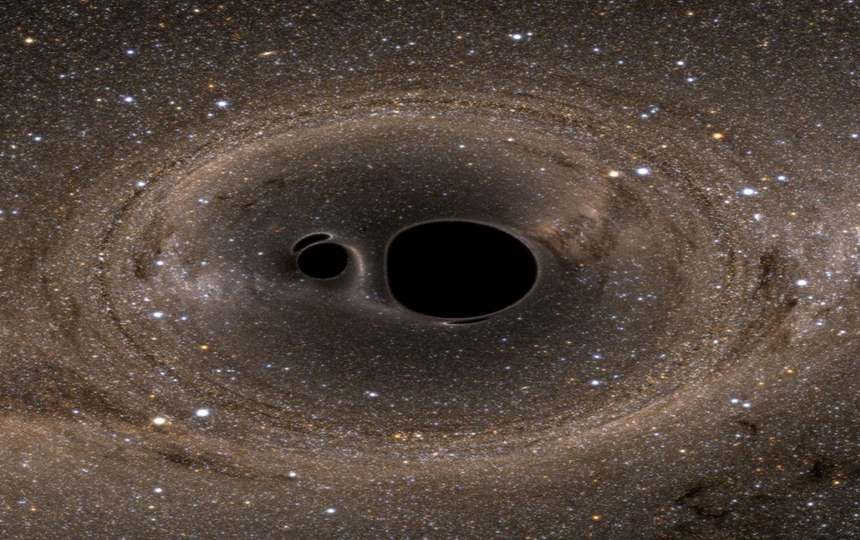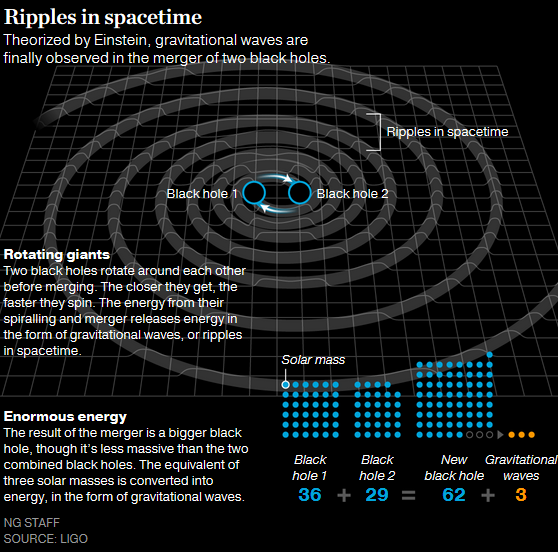
Earlier this month, a century’s worth of scientific theory was rendered fact as a team of scientists from the LIGO Laboratories declared that they recorded the first direct evidence of gravitational waves, ripples in the time and space continuum proposed by Albert Einstein in 1916. Using lasers and mirrors at two distinct laboratories 1,865 miles apart, the team observed disturbances in space-time caused by a pair of black holes colliding 1.33 billion light-years away.
The black holes, one 29 times the mass of the sun, and the other 36, coalesced into a single object and released 50 times more energy than all the stars in all the galaxies in the universe, causing an infinitesimal but observable effect at the two LIGO facilities. The results grant credence to Einstein’s vision of a universe in which time and space are only intertwined, but also dynamic, able to expand, contract, and jiggle.
In simplest terms, gravitational waves are ripples in space-time that travel at light speed carry gravitational energy from accelerating massive objects in space. Their effects are analogous to the rippling in a pond caused by a stone perforating the surface tension.
Until now, it was believed that gravity is caused by matter weighing down on the structure of the universe like a bowling ball in a tablecloth, but this recent discovery proves that Einstein was right all along: matter and energy distort the geometry of the universe. In other words, gravity is not solely an effect of mass but of both mass and energy.
These findings produce a dramatic paradigm shift, re-evaluating fundamental laws of physics that date back to Newton’s era, so much so, that Einstein himself faced mental turmoil comprehending its validity, flip-flopping multiple times on his prediction. But now, on Sept. 14, 2015, the LIGO’s L-shaped antennas registered a minute anomaly of subatomic proportions that can only be caused by gravitational waves sweeping through and displacing everything on a subatomic level.
What’s more, the discovery proves that black holes exist as spherical objects made of empty, warped space-time. All prior evidence was circumstantial and based on observations of the matter and gas surrounding the supposed black hole.

LIGO, or Short Laser Interferometer Gravitational-Wave Observatory, is a joint project between scientists from MIT, Caltech, and other universities, that operates two observatories in unison—the Livingston Observatory in Louisiana, and the DOE Hanford Observatory in Washington State. The two observatories are identical, featuring an L-shaped construction with two perpendicular arms measuring 2.5 miles in length. Within this space resides the world’s largest vacuum tubes, containing 2.5 million gallons of vacuum.
At the far end of each tube sits a pair of mirrors hanging on glass threads, with a laser measuring system aimed at each. This system, known as Advanced LIGO, can detect particle fluctuations as minute as one ten-thousandth of the diameter of a proton—making it sensitive enough to detect vibrations in extremely distant space-time geometry. LIGO was designed to detect vibrations originating from merging neutron stars, an event which causes observatories’ vacuum tubes to produce an audible chirp. But when such a sound originates from two converging black holes, the chirp is audibly different.
When the signal arrived on September 14, 2015, the frequency of the chirp was too low to be of a neutron star origin; immediately, LIGO’s three founding members—Dr. Rainer Weiss of Massachusetts Institute of Technology, Dr. Kip Thorne of California Institute of Technology, and Dr. Ronald Drever, also of Caltech—knew it was too loud to belong to neutron stars. Detailed analysis of its origin revealed the cacophony belonged to a pair of black holes in the far extremities of the universe.
Having cracked a major puzzle in Einstein’s theory of general relativity, physicists must now uncover evidence purporting the existence of gravitons, the particles believed to be responsible for transmitting gravity. Physicists hypothesize that gravity waves travel at light-speed because gravitons, like photons, exhibit no mass, thus fulfilling the prediction of the speed of gravitational waves in Einstein’s classical general relativity.
Source:LIGO , Nature , NYimes , and National Geographic

Advertisement
Learn more about Electronic Products Magazine





